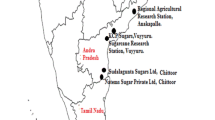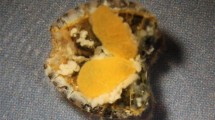Abstract
Riptortus pedestris F. [=R. clavatus (Thunberg)] is one of the most serious pests affecting the cultivation of sweet persimmon, which is one of the most important export fruits in Korea. A pheromone-baited trap has been used in attempts to control this pest. In this study, the development of a more efficient pheromone-baited trap for R. pedestris was pursued by investigating three different shapes of traps: the fish trap, the pyramidal trap, and the symmetry trap. The fish trap, which is the only one commercially available, captured the lowest number of R. pedestris, and the pyramidal trap showed moderate capture efficacy. The symmetry trap captured significantly greater numbers of R. pedestris adults (ca. 6 and 28 times more than the pyramidal and fish trap, respectively). Significantly increased trapping efficacy of the symmetry trap would be useful for mass trapping of R. pedestris.


Similar content being viewed by others
References
Abdul Alim M, Lim UT (2011) Refrigerated eggs of Riptortus pedestris (Hemiptera: Alydidae) added to aggregation pheromone traps increase field parasitism in soybean. J Econ Entomol 104:1833–1839
Adachi I, Uchino K, Mochizuki F (2007) Development of a pyramidal trap for monitoring fruit-piercing stink bugs baited with Plautia crossota stali (Hemiptera: Pentatomidae) aggregation pheromone. Appl Entomol Zool 42:425–431
Bae S-D, Kim H-J, Lee G-H, Yoon Y-N, Nam M-H (2010) Attractiveness of stink bugs to color, height and location of aggregation pheromone trap. Korean J Appl Entomol 49:325–331
Chung B-K, Kang S-W, Kwon J-H (1995) Damages, occurrences and control of Hemipterous insects in non-astringent persimmon orchards. RDA J Agric Sci 37:376–382
Gonzáez-Audino P, Gatti P, Zerba E (2011) Translucent pheromone traps increase trapping efficiency of ambrosia beetle Megaplatypus mutatus. Crop Prot 30:745–747
James DG, Heffer R, Amaike M (1996) Field attraction of Biprorulus bibax Breddin (Hemiptera: Pentatomidae) to synthetic aggregation pheromone and (E)-2-hexenal, a pentatoid defense chemical. J Chem Ecol 22:1697–1708
Kikuhara Y (2005) The Japanese species of the genus Riptortus (Heteroptera: Alydidae) with description of a new species. Jpn J Syst Entomol 11:229–311
Leal WS, Higuchi H, Mizutani N, Nakamori H, Kadosawa T, Ono M (1995) Multifunctional communication in Riptortus clavatus (Heteroptera: Alydidae): conspecific nymphs and egg parasitoid Ooencyrtus ezarae use the same adult attractant pheromone as chemical cue. J Chem Ecol 21:973–985
Lee HS, Chung BK, Kim TS, Kwon JH, Song WD, Rho CW (2009) Damage of sweet persimmon fruit by the inoculation date and number of stink bugs, Riptortus clavatus, Halyomorpha halys and Plautia stali. Korean J Appl Entomol 48:485–491
Lehman A, O’Rurke N, Hatcher L, Stepanski EJ (2005) JMP® for basic univariate and multivariate statistic. SAS Press, Cary
Paik C-H, Lee G-H, Oh Y-J, Park C-G, Hwang C-Y, Kim S–S (2009) Pheromone trap type and height for attracting of Riptortus clavatus (Thunberg) (Hemiptera: Alydidae) in soybean field. Korean J Appl Entomol 48:59–65
Seo MJ, Kwon HR, Yoon KS, Kang MA, Park MW, Jo SH, Shin HS, Kim SH, Kang EJ, Yu YM, Youn YN (2011) Seasonal occurrence, development and preference of Riptotortus pedestris on hairy vetch. Korean J Appl Entomol 50:47–53
Son C-K, Park S-G, hwang Y-H, Choi B-S (2000) Field occurrence of stink bug and its damage in soybean. Korean J Crop Sci 45:405–410
Yasuda T, Mizutani N, Endo N, Fukuda T, Matsuyama T, Ito K, Moriya S, Sasaki R (2007) A new component of attractive aggregation pheromone in the bean bug, Riptortus clavatus (Thunberg) (Heteroptera: Alydidae). Appl Entomol Zool 42:1–7
Acknowledgments
The author would like to thank the anonymous reviewers for their valuable comments and suggestions to improve the quality of the paper. I am very grateful to S.-Y. Hong and J.-S. Yang for providing the sweet persimmon orchard for the field test. This work received financial support from the Rural Development Agency (PJ907109032011).
Author information
Authors and Affiliations
Corresponding author
Rights and permissions
About this article
Cite this article
Kim, J. Development of a new shape of pheromone trap for the bean bug, Riptortus pedestris (Hemiptera: Alydidae). Appl Entomol Zool 47, 153–156 (2012). https://doi.org/10.1007/s13355-012-0102-1
Received:
Accepted:
Published:
Issue Date:
DOI: https://doi.org/10.1007/s13355-012-0102-1




